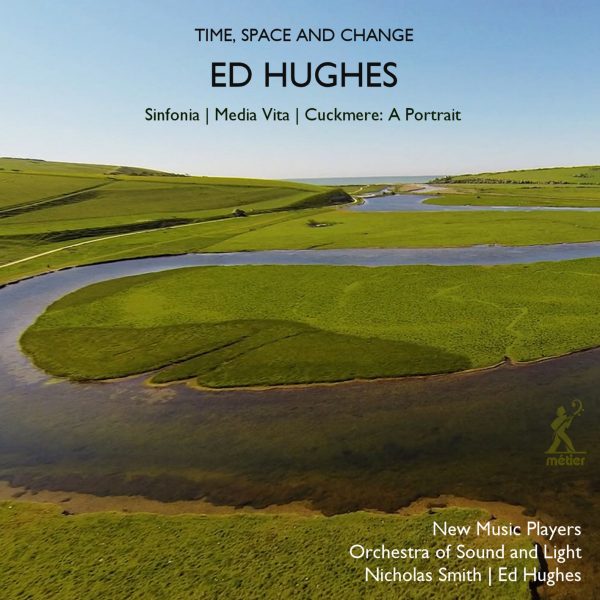Fanfare
Time, Space and Change, a CD from the Metier label, features the music of the English compos¬er, conductor, and educator Ed Hughes (b. 1968). In an autobiographical sketch included on his website (edhughescomposer.com), Hughes acknowledges two areas that are of compelling interest to him; English music (c. 1400-1700), and film. Both are represented in this CD. The disc opens with Cuckmere: A Portrait (2016-18). Hughes composed this music as the soundtrack to Cesca Eaton’s film of the same name. Both the film and Hughes’s score were commissioned by the Brighton Festival for live presentation. In liner notes for this release, Eleanor Knight explains that Eaton’s film “depicts a year in the life of the River Cuckmere and Haven, an area of undeveloped flood plain in East Sussex where the river winds towards the feet of the chalk cliffs known as The Seven Sisters, and out into the English Channel.” Hughes further explains that he and Eaton “decided to use moving images and music to create a kind of poetic, contemporary silent film with music, with two main themes: (1) changing seasons (time); and (2) the river’s journey from source to sea (space).” Hughes’s score for a large chamber ensemble depicts the River Cuckmere during the four seasons, commencing with Autumn. The work opens with an electronic prelude, and three electronic interludes serve to connect one season to the next. In the autobiographical sketch I mentioned earlier, Hughes concludes, “Key words for me in music are ‘harmony’, ‘colour’, and ‘rhythm’.” Both the ever-flowing River Cuckmere and its environment’s changing seasons are depicted by Hughes’s introduction and constant metamorphosis of melodic and rhythmic cells, cast in varied and colorful instrumental guises that often adopt a bright, optimistic tone. It’s an engaging, energetic, and lovely score that stands on its own as a concert work, independent of its function as a partner to the Eaton film.
Sinfonia (2018) reflects Hughes’s love for the history and tradition of English music. The work is based upon English vocal pieces from between 1400-1600. The first five movements are the com¬poser’s “portraits” of such vocal works (“Agincourt,” “Stella Celi Extirpavit,” “Veni Sancte Spiritus,” “In iejunio et fletu,” and “Silver Swan”). The sixth (“In Nomine”) combines music inspired by works of the In Nomine genre, interweaving with sounds of more contemporary London life. Hughes views and presents the various early vocal works through the prism of his modem aesthetic. To my ears, the work charts a journey that moves from darkness to light, both in its harmonic basis, and instrumental colors and textures. As in Cuckmere: A Portrait, Hughes demonstrates a mastery in the creation and metamorphosis of his foundational materials. Situated between these two works is an early Hughes composition for piano trio, Media Vita (1991). The 10-minute piece was inspired by a motet of the same name by 16th-century composer John Sheppard. Hughes describes it as encompassing “changes between an earthy, rhythmic character to passages which are more ecstatic and free of regular pulse.” To this I’d add that Media Vita presents an intriguing juxtaposition of dissonant and atonal voices with a more traditional melodic approach.
The performances of all three works feature admirable precision, energy, and relishing of Hughes’s rich and varied instrumental palette. The fine recorded sound complements the performers’ worthy efforts. Eleanor Knight’s introductory essay and the composer’s program notes are both engaging and informative. Time, Space and Change documents the work of an intriguing, compelling, and inventive contemporary voice. Recommended.
@divineartrecordingsgroup
A First Inversion Company
Registered Office:
176-178 Pontefract Road, Cudworth, Barnsley S72 8BE
+44 1226 596703
Fort Worth, TX 76110
+1.682.233.4978




![Listen to the full suite of Marcel Dupré’s Variations Sur un Noël, Op. 20 from Alexander Ffinch’s #Expectations release today! listn.fm/expectations [in bio]](https://scontent-dfw5-1.cdninstagram.com/v/t51.71878-15/588904367_2327488161082898_8709236950834211856_n.jpg?stp=dst-jpg_e35_tt6&_nc_cat=105&ccb=7-5&_nc_sid=18de74&efg=eyJlZmdfdGFnIjoiQ0xJUFMuYmVzdF9pbWFnZV91cmxnZW4uQzMifQ%3D%3D&_nc_ohc=6Hmi-5Sxz4wQ7kNvwEKF_cg&_nc_oc=AdmfUev2Z4pE3LqBImMuI7-2kCwwMYVrTqQbm0tL5EYpT7CaQMzIBZMcmz5fZmMH-W8&_nc_zt=23&_nc_ht=scontent-dfw5-1.cdninstagram.com&edm=ANo9K5cEAAAA&_nc_gid=1umDds_DSRvmiKhxpGZYQQ&oh=00_AfmirKuD4uu7qCIyPjr1m6uyGsONx_Ntl1scRGAbbPL4dA&oe=694364AA)

![“the ‘Manteca’ Paraphrase – a rare foray into the two-piano medium but here played double-tracked – exudes a panache of which Dizzy Gillespie would surely have approved.… [a] recital well worth investigating.” —Gramophone Magazine with high praise for Ophelia Gordon's debut release, Kapustin: Between the Lines!](https://scontent-dfw5-3.cdninstagram.com/v/t51.82787-15/598796470_18303255136283342_540941604740887837_n.jpg?stp=dst-jpg_e35_tt6&_nc_cat=108&ccb=7-5&_nc_sid=18de74&efg=eyJlZmdfdGFnIjoiRkVFRC5iZXN0X2ltYWdlX3VybGdlbi5DMyJ9&_nc_ohc=6FiEgYiNOZUQ7kNvwGh4i_d&_nc_oc=Adk99BfMJCNGctqW4iHb2N7CLKX1MusvVFMVOw8LIyLZ8XWZmZbY-3dsF18K5b7tnwQ&_nc_zt=23&_nc_ht=scontent-dfw5-3.cdninstagram.com&edm=ANo9K5cEAAAA&_nc_gid=1umDds_DSRvmiKhxpGZYQQ&oh=00_Afk8y0aNixT2Tyxc8g3LW70PJcF3IkicWIp1NCg72OEbBg&oe=69437744)





